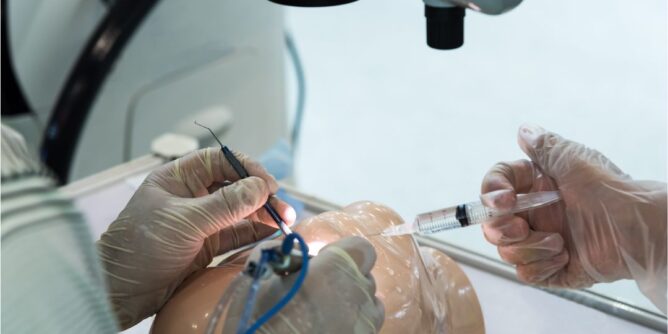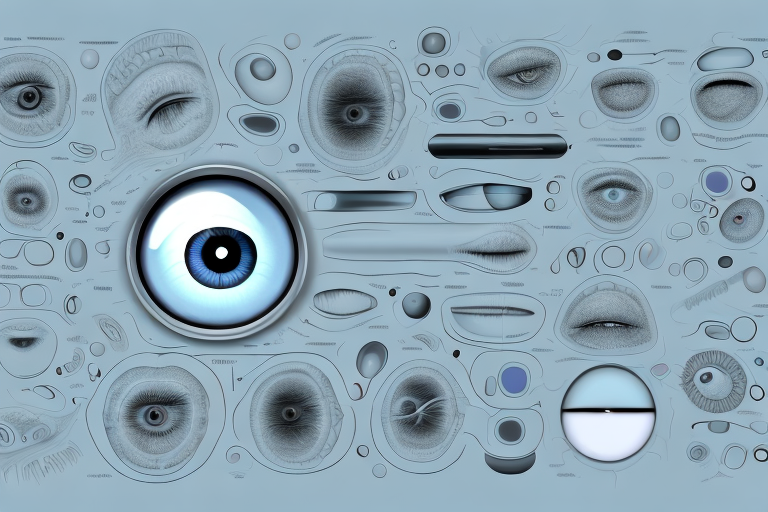
The retina plays a vital role in our vision. Understanding its function and the various conditions that can affect it is crucial for diagnosing and treating retinal diseases effectively. In this comprehensive guide, we will delve into the intricacies of retinal treatments and explore the different eye conditions they address.
Understanding the Function of the Retina
The retina is a thin layer of tissue that lines the back of the eye. Its primary function is to capture light and convert it into neural signals that are sent to the brain for interpretation. This intricate process allows us to see and perceive the world around us. The retina consists of specialized cells called photoreceptors, which detect light and initiate the visual process.
One key component of the retina is the macula, which is responsible for central vision and fine detail. Damage to the macula can have a significant impact on a person’s ability to read, recognize faces, and undertake tasks that require sharp visual acuity.
The retina is a fascinating structure that plays a crucial role in our vision. Let’s delve deeper into its function and explore the various disorders that can affect its proper functioning.
The Role of the Retina in Vision
The retina acts as a complex sensory organ, translating light into signals that can be interpreted by the brain. When light enters the eye, it passes through the cornea and lens, ultimately reaching the retina. The retina contains photoreceptor cells, known as rods and cones, which convert light energy into electrical signals. These signals are then transmitted to the brain via the optic nerve, where they are interpreted as visual information.
Rods are responsible for vision in low-light conditions, allowing us to see in dimly lit environments. On the other hand, cones enable color vision and visual acuity in bright light. They are concentrated in the macula, which is why we can perceive fine details and vibrant colors in our central vision.
The intricate interplay between rods and cones, along with the complex neural connections within the retina, allows us to experience the world in all its visual glory. It is truly remarkable how this delicate tissue can capture light and transform it into meaningful visual information.
Common Retinal Disorders and Their Symptoms
While the retina is a remarkable structure, it is not immune to various disorders that can impair vision and affect its proper functioning. Understanding these conditions is crucial for early detection and appropriate treatment. Here are some common retinal disorders:
Age-Related Macular Degeneration (AMD)
AMD is a progressive condition that primarily affects older adults, causing a loss of central vision. It is one of the leading causes of vision loss in the elderly population. Symptoms of AMD may include blurry or distorted vision and a dark or blurry spot in the center of the visual field. Early detection and timely intervention are essential in managing this condition and preserving vision. By https://northwestobesitysurgery.com/what-is-prk-is-it-wise-to-go-for-it/ visiting you can read about What is PRK, Is It Wise to Go for It?

Diabetic Retinopathy
Diabetic retinopathy is a complication of diabetes that damages blood vessels in the retina. It is a significant cause of vision loss among individuals with diabetes. Over time, high blood sugar levels can lead to the weakening and leakage of blood vessels, affecting the retina’s function. Symptoms of diabetic retinopathy may include floaters, blurred vision, and difficulty seeing at night. Strict blood sugar control and regular eye examinations are crucial in managing this condition and preventing further vision loss.
Retinal Detachment
Retinal detachment occurs when the retina peels away from its normal position, leading to a loss of vision. It is a medical emergency that requires immediate attention. Symptoms of retinal detachment include the sudden appearance of floaters, flashes of light, and a curtain-like shadow over the visual field. Prompt surgical intervention is necessary to reattach the retina and restore vision.
Retinitis Pigmentosa
Retinitis pigmentosa is a genetic disorder that causes the gradual degeneration of the retina. It is characterized by the progressive loss of photoreceptor cells, leading to vision impairment. Symptoms typically include difficulty seeing in low light, tunnel vision, and eventual loss of peripheral vision. While there is currently no cure for retinitis pigmentosa, various treatment options and visual aids can help individuals manage their symptoms and maintain their quality of life.
These are just a few examples of the many retinal disorders that can impact vision. It is essential to consult with an eye care professional if you experience any changes in your vision or have concerns about your eye health. Early diagnosis and appropriate management can make a significant difference in preserving and enhancing your visual function.
Overview of Retinal Diseases
Retinal diseases encompass a broad range of conditions that can be categorized into different types based on their underlying causes and symptoms. Understanding these diseases is essential for accurate diagnosis and effective treatment.
Retinal diseases can have a significant impact on an individual’s vision and quality of life. They can affect people of all ages, although some conditions are more common in older adults or individuals with certain medical conditions. It is important to be aware of the different types of retinal diseases and their treatment options to ensure timely intervention and management. Click here to read about Eye checks and glasses.
Age-Related Macular Degeneration (AMD)
AMD is the leading cause of vision loss among older adults. It can be classified into two types: dry AMD and wet AMD. Dry AMD involves the breakdown of light-sensitive cells in the macula, while wet AMD is characterized by abnormal blood vessel growth beneath the retina.
Age-related macular degeneration can have a profound impact on an individual’s ability to perform daily activities such as reading, driving, and recognizing faces. It is crucial for individuals at risk, such as those with a family history of AMD or smokers, to undergo regular eye examinations to detect the disease at an early stage.
Treatment options for AMD vary depending on the type and may include the use of medication, laser therapy, or surgical interventions. Medications such as anti-VEGF drugs can help slow down the progression of wet AMD by inhibiting the growth of abnormal blood vessels. Laser therapy can be used to seal leaking blood vessels, while surgical interventions may be necessary in advanced cases to restore vision.
Diabetic Retinopathy
Diabetic retinopathy is a complication of diabetes that affects the blood vessels in the retina. It can be classified into non-proliferative diabetic retinopathy (NPDR) and proliferative diabetic retinopathy (PDR), with PDR being the more severe form.
Diabetic retinopathy is a common cause of vision loss among individuals with diabetes. It is essential for individuals with diabetes to manage their blood sugar levels and undergo regular eye examinations to detect and monitor the progression of retinopathy.
Treatment options for diabetic retinopathy may include medication, laser therapy, or surgery, depending on the extent of the disease. Medications such as corticosteroids or anti-VEGF drugs can help reduce swelling and prevent the growth of abnormal blood vessels. Laser therapy can be used to seal leaking blood vessels and prevent further damage to the retina. In advanced cases, surgery may be necessary to remove scar tissue or blood from the eye.
Retinal Detachment
Retinal detachment occurs when the retina detaches from the underlying tissue layers. This separation can disrupt blood flow and cause permanent vision loss if not promptly treated.
Retinal detachment can occur due to various reasons, including trauma, aging, or underlying eye conditions. It is considered a medical emergency, and immediate medical attention is required to prevent irreversible vision loss.
Treatment options for retinal detachment typically involve surgical procedures aimed at reattaching the retina and sealing any tears or breaks. The specific surgical technique used depends on the severity and location of the detachment. Common surgical procedures include scleral buckle surgery, vitrectomy, and pneumatic retinopexy.
Retinitis Pigmentosa
Retinitis pigmentosa is a genetic disorder characterized by the progressive degeneration of the retinal cells. It is typically inherited and can lead to severe vision impairment or blindness.
Retinitis pigmentosa affects the rod and cone cells in the retina, which are responsible for detecting light and color. As these cells degenerate, individuals with retinitis pigmentosa may experience night blindness, tunnel vision, and difficulty with peripheral vision.
There is currently no known cure for retinitis pigmentosa, but various treatment options aim to manage symptoms and slow the progression of the disease. These may include visual aids, low-vision rehabilitation, and gene therapies that show promising results in ongoing research. Visual aids such as magnifiers, telescopic lenses, and electronic devices can help individuals with retinitis pigmentosa make the most of their remaining vision. Low-vision rehabilitation programs can provide training and support to help individuals adapt to their visual impairment and maintain independence in daily activities.
Ongoing research in gene therapies holds promise for the future treatment of retinitis pigmentosa. These therapies aim to correct or replace the faulty genes responsible for the disease, potentially slowing down or halting its progression.
Diagnostic Procedures for Retinal Diseases
To accurately diagnose retinal diseases and develop appropriate treatment plans, ophthalmologists rely on a range of diagnostic procedures.
Ophthalmoscopy Examination
Ophthalmoscopy, also known as funduscopy, involves examining the inside of the eye, including the retina, using a specialized instrument called an ophthalmoscope. This procedure allows ophthalmologists to assess the health of the retina, identify abnormalities, and detect signs of retinal diseases.
Fluorescein Angiography
Fluorescein angiography is a diagnostic procedure that involves injecting a fluorescent dye into a vein in the arm. As the dye circulates through the blood vessels in the retina, specialized imaging equipment captures images that reveal abnormal blood vessel growth, leakage, or blockages. This information can aid in the diagnosis and treatment of retinal diseases such as AMD and diabetic retinopathy.
Optical Coherence Tomography
Optical coherence tomography (OCT) is a non-invasive imaging technique that provides high-resolution, cross-sectional images of the retina. It allows ophthalmologists to visualize the layers of the retina and identify any abnormalities or changes in thickness. OCT is particularly useful in diagnosing conditions like macular degeneration, diabetic retinopathy, and retinal detachment.
Non-Surgical Retinal Treatments
While surgical interventions are often necessary for severe retinal conditions, non-surgical treatments can be effective in managing certain retinal diseases.
Medication for Retinal Diseases
Medication can be prescribed to treat and manage retinal diseases such as wet AMD and diabetic macular edema. Anti-vascular endothelial growth factor (anti-VEGF) injections are commonly used to inhibit abnormal blood vessel growth and reduce fluid accumulation in the retina. Corticosteroids may also be prescribed to reduce inflammation and swelling.
Laser Therapy for Retinal Conditions
Laser therapy has proven to be effective in treating retinal diseases like diabetic retinopathy and retinal tears. It involves using a laser to target and seal leaking blood vessels or to create small burns that stimulate the healing process. Laser therapy can help prevent further damage to the retina and preserve vision in certain cases.
In conclusion, understanding the function of the retina and the various retinal diseases is crucial for effective diagnosis and treatment. Diagnostic procedures such as ophthalmoscopy, fluorescein angiography, and optical coherence tomography aid in identifying retinal abnormalities and guiding treatment decisions. Non-surgical treatments, including medication and laser therapy, offer promising options for managing retinal conditions. By staying informed about retinal treatments, one can take proactive steps in preserving and protecting their precious vision.
